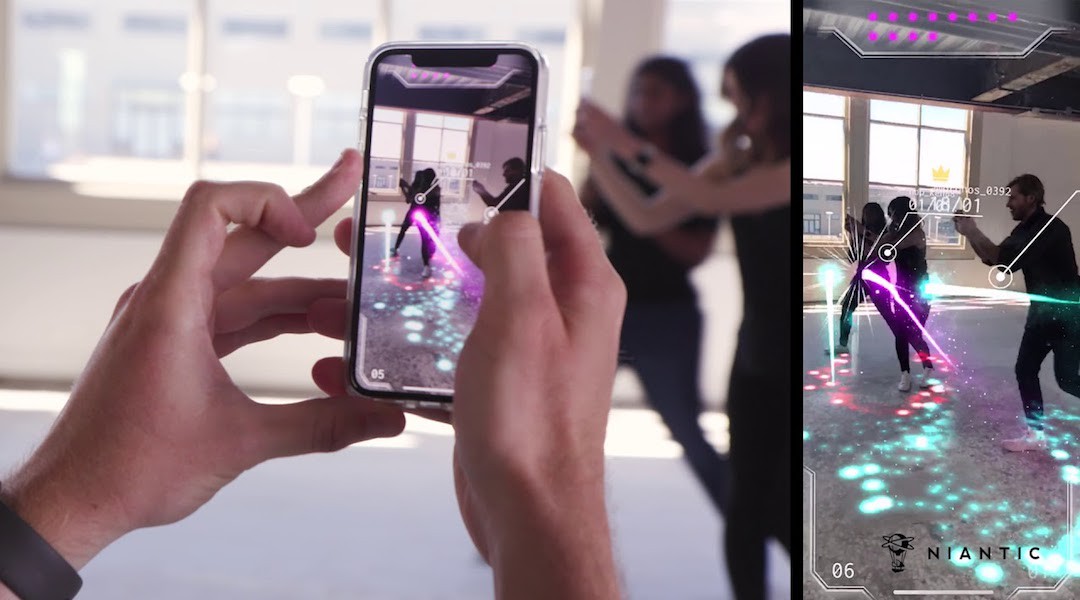
Joining the lexicon of tech buzzwords (blockchain, voice-enabled, etc.) is the next inflection in connectivity: 5G. It was the breakout topic of Mobile World Congress last month, and it has tech and media world’s buzzing about new capabilities.
So naturally, our question is: What will it do for AR and spatial computing? Answering that requires first answering, what is 5G? There are surface-level benefits like 100x faster speeds than 4G/LTE. So with increasing mobile data consumption, 5G speed will enable our streaming addictions.
But it goes beyond speed. 5G will enable all kinds of new consumer use cases and content delivery strategies. That includes more precise location-targeted content, and lots of indoor use cases like retail commerce. As much as we love GPS, satellites don’t go indoors.

Low-Range, High Frequency
So why is 5G better? It’s a low-range, high-frequency signal, so base stations will be clustered densely. Instead of cell towers spread out like today, tiny 5G stations will blanket areas in a sort of edge-computing mesh network that distributes bandwidth and processing optimally to each user.
“As we build 5G out, these stations can have compute data centers at their base,” said Deutche Telekom’s Terry Schussler at the AWE conference. “The distribution of that compute is going to be intelligently performed by software that allows the orchestration of where it should come from.”
This allows for those same stations to more accurately triangulate spatial positioning, compared with cell towers today and even GPS. The latter boasts meter-level accuracy, but 5G will have millimeter accuracy in many cases. That unlocks a few new possibilities for content delivery.
For example, the AR cloud will let devices to understand their surroundings and anchor graphics accordingly. This can make or break multi-player AR experiences and retail AR. 5G will enable these AR cloud functions through more precise location tracking and device localization.
“It’s not that edge is going to replace the cloud, it’s just going to move the cloud closer to the user,” said Deutsche Telekom director of immersive technologies Terry Schussler at AWE Europe. “We control data transfer at the speed of light, so if we shorten the distance from the data center to the user, we can reduce milliseconds of latency that occur on the Internet.”
Down to the Millimeter
AR involves lots of underlying tech like computer vision and machine learning. But another element referenced above is “localization,” (the L in SLAM), which is an AR device’s ability to calculate its own position in space. That’s where 5G’s millimeter-level accuracy will come in handy.
“It will improve the precision of the mobile location by one or two orders of magnitude,” Here Technologies’ Kirk Mitchel told CMS Wire. “We believe that location will play a critical role in … driving the leading use cases of 5G … enabling sub-meter positioning to enable precise location.”
Magic Leap is big on this vision, and it knows 5G is a key piece of the puzzle. At Leapcon, CEO Rony Abovitz unpacked his construct of the magicverse — a series of data layers activated by AR devices on demand. It requires the precision and low latency Schussler referenced.
“[It’s] almost a digital soul for a physical place. You could think that’s a room, that’s a building, that’s a coffee house, that’s an entire city,” said Abovitz. “When you put incredibly high-speed networks like 5G in those cities, it becomes a platform to develop the most amazing things.”
Niantic similarly sees 5G unlocking long-term vision for mobile AR. Mobile is the key word, given the mobility of Pokemon Go, and of the company’s mission statement to get people outside. This makes high-performance connectivity to far-flung devices a key enabler in its road map.
“5G for us enables a new level of gameplay,” said Niantic CTO Phil Keslin in a recently released video, adding that shared experience and movement will benefit from 5G: “In order to create that experience, you need incredibly high bandwidth and incredibly low latency.”

Local Commerce’s Last Mile
This reaches new levels of value and untapped potential when we bring it inside. Building interiors are the last frontier for location tracking, given the drawbacks of GPS or failed standards like retail beacons. In fact, 5G could step in to fully realize the unfulfilled promise of beacons.
The retail use cases this could unlock involve lots of innovations that are already happening under the “retail as a service (RAAS)” designation. That includes Amazon Go-like capability for cashier-less stores, in-aisle payments, and shopping assistance through in-store AR experiences.
5G’s targeting precision will bring this retail vision closer to reality. It can enable more reliability in actions like knowing when you’ve put something in your cart. And it will unlock other functions like identity tracking for payments, targeted in-store messaging, and in-aisle AR.
Beyond retail, 5G could assist the mobile advertising subsector of location targeting (which impacts AR). A longstanding challenge is that location signals are unreliable. Ad networks will sell location-targeted ads at a premium, which are actually off by miles. 5G could help that.
When looking at leaders in location tracking such as Foursquare, its signature stop data to measure users’ “real stops” at a given business (as opposed to walking by) can gain even more reliability. This will shine in dense urban areas, shopping malls and other commercial zones.
“5G is not inherently focused on location, though the frequency range and likely network deployment topology will improve location capabilities via better triangulation,” Foursquare SVP of engineering Matthew Kamen said in an email. “Further, increased bandwidth and lower latency will, at some point, reduce restrictions in network communications. That will make it easier for developers to make more frequent and heavier payload requests to servers. All of this is advantageous to us as a location technology platform, as we provide tools for Fortune 500 brands and tech companies wanting to understand and reach audiences as they move through the world.”
As for when? CSS insights projects 340 million 5G connections in 2021, then one billion in the first half of 2023 and 2.7 billion (about a third of the world’s population) by 2025. Another bottleneck is hardware: 5G-enabled phones will phase in over the next three years. Then, it’s off to the races.
“Every new technology needs an application to really highlight the capabilities of that technology,” said Niantic’s Keslin. “Augmented reality is truly the killer app for 5G.”
For deeper XR data and intelligence, join ARtillry PRO and subscribe to the free ARtillry Weekly newsletter.
Disclosure: ARtillry has no financial stake in the companies mentioned in this post, nor received payment for its production. Disclosure and ethics policy can be seen here.
Header image credit: Niantic
